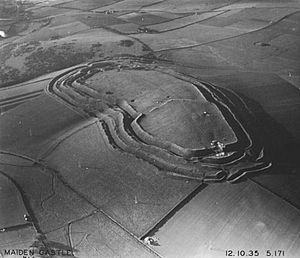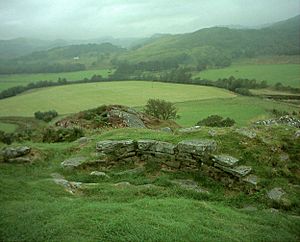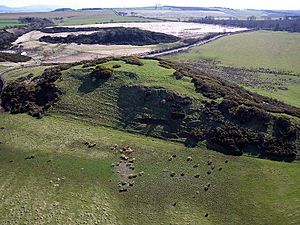Hillforts in Britain facts for kids
Hillforts in Britain are ancient, large settlements or forts built on hills. People in Great Britain built them a long time ago. The very first ones appeared in the Stone Age, and some were also built in the Bronze Age. But most British hillforts were built during the British Iron Age.
When the Romans came to southern Britain, many hillforts there were no longer used. However, in northern Britain, where the Romans did not conquer, more hillforts were built. Some hillforts were used again in the Early Middle Ages, and a few even later. By the early modern period, most were empty. Today, archaeologists study them to learn about the past.
There are about 3,300 hillforts or similar "defended enclosures" in Britain. Most are found in specific areas: south and south-west England, the west coast of Wales and Scotland, the Welsh Marches, and the Scottish border hills. Hillforts came in different sizes. Most were smaller than 1 hectare (about 2.5 acres). Others ranged up to 12 hectares (about 30 acres). A few rare ones were very big, over 80 hectares (about 200 acres).
Some experts don't like the word "hillfort." They say not all sites were on hills, and not all were just for fighting. They prefer terms like "enclosed places" or "defensive enclosures."
Contents
Bronze Age Hillforts: Early Strongholds
The first hillforts in Britain appeared in the Late Bronze Age. Experts believe they were part of big changes in how people lived and organized their societies. This was when:
- Old burial customs disappeared.
- More valuable metal items were placed in rivers.
- The old way of living in groups of round houses inside enclosures ended.
Early hillforts were often built in places that already had important ancient monuments. This might have helped the builders connect their new ways of life to the past. For example, many Iron Age hillforts were built near older Bronze Age burial mounds. Both types of monuments were often on high ground. Some thought hillforts might have been placed near burial sites for extra protection, perhaps because people believed these places had sacred powers.

Iron Age Hillforts: Dominating the Landscape
Iron Age hillforts are still very noticeable in the British landscape. They show the amazing building skills and social organization of the Iron Age people. They impress us with their huge size, tall walls, deep ditches, and the large areas they enclose. They are often found in commanding positions.
There were many different kinds of hillforts in the British Iron Age. They are usually grouped into four main types:
- Contour forts: These follow the natural shape of a hill, cutting off the top part with defenses that go around the hill's curves.
- Promontory forts: These are built on land that is naturally protected on most sides by features like cliffs, very steep slopes, or rivers. Less man-made defense was needed here.
- Hill-slope forts: Instead of enclosing the very top of a hill, these are built on the sloping ground on one side, with the hill crest overlooking them.
- Plateau forts: These are on flat ground on all sides, no matter how high they are. They are often found on plateaus.
Iron Age hillforts used both natural and man-made defenses. Natural defenses included cliffs, steep slopes, rivers, lakes, and the sea. Man-made defenses mostly involved banks and ditches.
There were two main types of banks:
- Revetted banks: These had a straight or nearly straight outer face, often made of timber or dry stone walls. This face held back a core of earth or chalk.
- Glacis banks: These were usually triangular in shape and were simply a pile of material dug from the ditch.
Some hillforts had only one rampart (called univallate), while others had many ramparts (called multivallate). About one-third of Iron Age forts in England and Wales had multiple ramparts. It's thought that only the innermost rampart was actively defended, with the others helping to create space and break up enemy attacks.
Why Were Hillforts Built?
The exact reason why British Iron Age people built hillforts is still debated. For a long time, many archaeologists thought they were mainly for defense during wars between tribes. However, in recent years, some experts have questioned this. They say there isn't enough proof that all hillforts were built for fighting.
It's likely that hillforts had different purposes. Their function might have changed over time.
Were They for Defense?
Many people have traditionally believed that hillforts were built for defense in the Iron Age. Some archaeologists think that warfare was a common part of life for farming societies, so it makes sense that hillforts were built as defensive positions.
However, some experts disagree. They point out that many hillforts were not built in the best places for defense. For example, at Scratchbury hillfort, attackers could easily see the defenders' positions, making it vulnerable. Also, many hillforts in south-east England had only one rampart and lacked the deep, complex defenses seen elsewhere.
One idea is that Iron Age warfare wasn't always about direct fighting. It might have involved a lot of showing off and threatening behavior. In this view, hillforts could have been built to look threatening to enemies, rather than to be practically defended in a real battle. They might have been more symbolic than truly defensive.
Were They for Ceremonies?
Some archaeologists suggest that hillforts also had ceremonial purposes. This idea isn't new, but discussions often focused on finding shrines or temples inside the forts. Now, some think the shape and location of the ramparts themselves might point to ceremonial activities.
It's also important to think about how people experienced hillforts within their landscape. Hillforts offered special places from which to view the world. This changing view was likely a very important part of how the builders and users understood these impressive sites.
Southern Britain: Roman Times
In the 1st century CE, southern Britain was conquered by the Roman Empire. This led to a mix of Roman and British cultures, known as Roman Britain.
Many hillforts in Roman Britain seem to have been abandoned. For example, at Dinas Powys hillfort in South Wales, archaeologists found Roman artifacts, but not enough to suggest people lived there. There was also no sign of new building during the first four centuries CE. This suggests Dinas Powys was left empty under Roman rule.
However, in the far southwest, like in Cornwall, smaller enclosed settlements continued to be built. Examples include Chysauster and the 'Rounds'. This probably shows that Roman influence was weaker in these areas. These smaller settlements continued to be used into the period after Roman rule.
Northern Britain: Beyond Roman Rule
The Roman Empire never conquered northern Britain (which is mostly modern-day Scotland). So, the native British Iron Age culture continued there with less Roman interference. This affected hillforts in the region.
After a quiet period in the early centuries CE, a new wave of fort building began in the 3rd century. It grew stronger in the 5th century and perhaps lasted until the 8th century. About half of the northern forts with known dates were either old forts that were rebuilt, or new ones built from scratch during this later period.
Early Medieval Hillforts: A New Era
The Early Medieval period began in the 5th century CE. In much of southern Britain (which later became England), people adopted a new culture from Germanic groups who migrated from Europe. These people, called the Anglo-Saxons, generally did not build or reuse hillforts.
However, in Northern and Western Britain, where cultural links to the earlier Iron Age remained strong, hillforts continued to be used. The massive hillforts of the pre-Roman Iron Age required a lot of labor and a different social organization. These conditions no longer existed in the 5th and 6th centuries CE. This shows a big change in how society was organized.
Western Britain: Continuing Traditions
In Wales and the West Country, British Iron Age culture continued, largely without adopting Anglo-Saxon ways. For example, Dinas Powys hillfort in South Wales was resettled in the 5th century. South Cadbury Hillfort also shows signs of a large hall being built inside its walls during this time. This site has long been linked to the mythical Camelot.
Other defensive sites were also reoccupied. On the defensive peninsula of Tintagel in Cornwall, a promontory fort known as Tintagel Castle was built in the Early Medieval period. Archaeologists believe it was a stronghold for the post-Roman kings of Dumnonia. Several similar promontory forts of Cornwall and in nearby Brittany show signs of being used during this period. They are often connected with early Christian hermitages or chapels, like at Rame Head or St Michael's Mount. A later example is Castell Dinas Brân, where an Iron Age hillfort from around 600 BCE became the site of a stone castle built in the 13th century CE.
Northern Britain: Forts for the Elite
Northern Britain was never conquered by the Roman Empire. So, the Iron Age there moved directly into the Early Medieval period without Roman rule. Warfare was perhaps a very important social activity in early historic northern Britain. For this reason, many hillforts from this period are thought to be defensive structures built to stop attacks.
Hillforts used in the Early Medieval period seem to have been mainly settlements for the most important people in society, the ruling classes. The people in northern Britain who built these forts knew about different types of monuments. They used them in various ways, depending on the local land, building materials, and their political or military needs.
See also
 In Spanish: Castros en Gran Bretaña para niños
In Spanish: Castros en Gran Bretaña para niños



